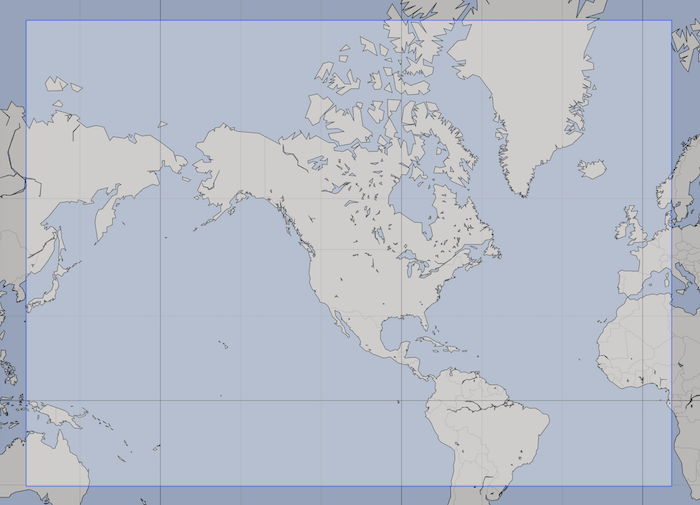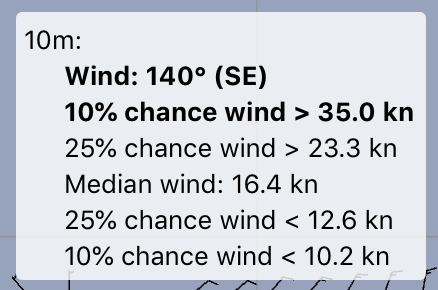
NBM Oceanic (National Blend of Models)
| Provider: | National Weather Service, NOAA (USA) |
| Model scope: | Atlantic, North America, Pacific |
| Update frequency: | for UTC hours 00, 07, 12, 19 |
| Resolution: | 0.09°, 5.4nm, 10.0km |
| Model duration: | 40 forecasts starting at 0 hr, ending at 11 days |
| Parameters: | wind, wind gust, probabilistic wind, probabilistic pressure, temperature, swell/wave combined, ensemble standard deviation, other |
| GRIB model date: | Tue Jul 15 12:00:00 2025 UTC |
| Download date: | Tue Jul 15 18:06:30 2025 UTC |
| Download delay: | 6hr 06min |
Note: the Download delay is the amount of time required for the GRIB model to compute its forecast and then for the LuckGrib cluster to download the data and make it available. The LuckGrib delay is generally less than 10 minutes, the remainder of the delay is the model compute time.
NBM Oceanic
There are four NBM models available, with NBM Oceanic having by far the largest domain, covering most of the Pacific and Atlantic oceans, down to 30° south at a nominal 10km resolution (0.09°.)
Note that GFS, the most popular global weather model, offers a 0.25° resolution. 0.25° is roughly 28km. The Oceanic domain of the NBM is almost three times the resolution of GFS. Some of the other global models are GEFS at 0.5°, Canadian GDPS at 0.15°, WW3 at 0.5°, DWD Global Wave at 0.5°.
While NBM Oceanic is not a global model, it covers an interesting domain at a finer resolution than has been previously available.
The Oceanic data is also interesting in that it presents probabalistic wind information. Rather than simply presenting a single value for its wind parameters at a point, this model presents five wind speeds with associated probabilities. By examining the spread of these wind speeds, you can make determinations on the certainty of the result.
 Example of protability winds.
Example of protability winds.NBM Oceanic is a weather forecast model which is able to express the degree of certainty it has in its results. This is a crucial difference between this model and most other models (ensemble models, such as GEFS, are also able to express uncertainty in their data, through standard deviation.)
A short tutorial is available, describing the NBM Oceanic probabilistic data in some more detail.
Note that the Weather Routing product is able to generate routes using the different probability wind values. This will present a range of routes for you to consider.
This is a new resource for the weather community to consider. Feedack is welcome on how useful you find this model.
About the National Blend of Models
The National Blend of Models (NBM) is an interesting suite of models, well worth considering as you evaluate weather systems.
The following is from an online description of the NBM:
The National Blend of Models (NBM) is a nationally consistent and skillful suite of calibrated forecast guidance based on a blend of both NWS and non-NWS numerical weather prediction model data and post-processed model guidance. The goal of the NBM is to create a highly accurate, skillful and consistent starting point for the gridded forecast. This new way to produce NDFD grids will be helpful providing forecasters with a suite of information to use for their forecasts. The NBM is considered an important part of the efforts to evolve NWS capabilities to achieve a Weather-Ready Nation.
As of Oct/2020, the NBM model is at version 4.0.
The quoted text above mentiones that both NWS and non-NWS models are blended into the NBM.
The list of model inputs, for version 3.0 of NBM, is:
- NAM (North American Mesoscale Forecast System - 12km)
- NAMNest (NAM 3km high resolution nest)
- GFS (Global Forecast System)
- GEFS (Global Ensemble Forecast System)
- GDPS (CMC - Environment Canada Global Deterministic – PoP12/QPF06 only)
- GEPS (CMCE - Environment Canada Global Ensemble)
- EKDMOS (Ensemble Kernel Density Model Output Statistics)
- Gridded GFS MOS (GMOS or MOSGuide)
- HRRR (High Resolution Rapid Refresh), CONUS only
- RAP (Rapid Refresh). (Also RAP Alaska)
- Gridded LAMP (GLMP Localized Aviation MOS Product), CONUS only
- HiResWindow ARW NCEP (High-Resolution Window Forecast System (HIRESW))
- HiResWindow NMMB NCEP (High-Resolution Window Forecast System (HIRESW))
- SREF (Short Range Ensemble Forecast) CONUS, Alaska, Puerto Rico sectors
- NAVGEME (Navy FNMOC Global Ensemble)
The update to NBM, version 3.1, has added the following model inputs:
- ECMWFD (European Centre for Medium-Range Weather Forecasts, deterministic - 0.25 degree)(CONUS, OCONUS) (0000, 1200 UTC runs)
- ECMWFE (European Centre for Medium-Range Weather Forecasts, Ensemble - 1.0 degree)(CONUS, OCONUS) (0000, 1200 UTC runs)
- NAVGEMD (Navy FNMOC Global deterministic - 0.50 degree For most elements, 1.0 degree for significant wave heights)(CONUS, OCONUS, and Oceanic domain) (0000, 0600, 1200, 1800 UTC runs)
- GDPS (CMCD Environment Canada Global deterministic model (25km) for weather elements other than PoP12/QPF06)
- RDPS (Canadian Regional deterministic model - 10km) (CONUS and Alaska) (0000, 0600, 1200, 1800 UTC runs)
- REPS (Canadian Regional ensemble model - 15km) (CONUS) (0000 and 1200 UTC runs) (Precipitation products only)
- HRRR Alaska (High Resolution Rapid Refresh - 3km) (a). 1-18 hours (0300, 0900, 1500, 2100 UTC runs) (b). 1-36 hours (0000, 0600, 1200, 1800 UTC runs)
- HiResWindow ARW Mem2 (3-km High-Resolution Window Forecast System (configured like NSSL WRF) (CONUS and OCONUS)
- WW3 (0.5 degree WaveWatchIII global deterministic model)
- WW3 (0.5 degree WaveWatchIII global ensemble model)
- WW3 (0.16 and 0.06 degree WaveWatchIII high resolution regional models) (CONUS and OCONUS)
- GLW (2.5km Great Lakes Wave model)
The v3.2 update to NBM has added the following model inputs:
- ACCESS-G (The Australian global model)
- GFS-FV3 visibility
- additional improvements for other weather elements (temperature, rain, …)
The v4.0 update to NBM has added the following model inputs:
- GFS-MOS (0000-, 0600-, 1200-, and 1800-UTC cycles)
- Deterministic ECMWF-MOS (0000- and 1200-UTC cycles)
- Ensemble ECMWF-MOS (0000- and 1200-UTC cycles)
- EKDMOS (0600- and 1800-UTC cycles)
- NAM-MOS (0000- and 1200-UTC cycles)
- LAMP (hourly)
The blending process
The word blend in NBM represents the key feature of this model. A wide variety of models are blended into the NBM final result. This blending process has been shown to improve the skill level present in the individual models.
Cliff Mass, an Atmospheric Science professor at the University of Washington, has published a presentation describing the blending process, referred to as MOS. The presentation is an interesting read, if you want to understand some of the techniques that may be present in the NBM blending process.
The blend in the NBM is different from an ensemble model in two major ways.
first, the blending in the NBM does not use simple averaging, and Prof. Mass’s paper talkes about how this may work, in some detail. The blending in NBM is much more sophisticated than a simple average, and it is able to improve the skill of the result as well as retain detail in the data.
secondly, the input models to the blend are from a wide variety of sources, both from NOAA and from outside of NOAA. For example, models from both Canada and the US Navy are included as elements of the blend. Both high resolution regional models and global models are considered. In a way, the NBM is a meta-ensemble, an advanced blending of other ensemble (and non-ensemble) models
The Mercator grid and a note on model resolution
In GRIB-2, GRIB data can be defined in a wide variety of different grids. These grids define the projection from points in the file to latitude/longitude points on earth.
The NBM Oceanic model uses the Mercator projection in its grid definition. The use of the Mercator grid for this data set has some interesting properties.
You will recall that the Mercator projection, as used in the majority of map projections, seems to elongate distances at higher latitudes. By using the Mercator projection grid in the GRIB data, the points end up evenly spaced in the final projection, at all latitudes.
To see this, download a file of the entire NBM Oceanic domain and then zoom into the data and scroll north and south. The grid spacing you see will be constant. A consequence of this grid spacing is that the resolution of the model improves as you increase latitude.
The nominal resolution of this model is 10km. However, the actual local resolution around San Francisco is approximately 8km. Seattle has a local resolution of around 7km. Alaska is down to approximately a 5km resolution.
LuckGrib is one of the very few GRIB viewers that will show you the data in its original grid. Most of the GRIB viewers will either not be able to display this data in its native form, or will convert it to a simple latitude/longitude form, which loses this improvement in resolution at higher latitude.
Additional Information
For additional information, see: